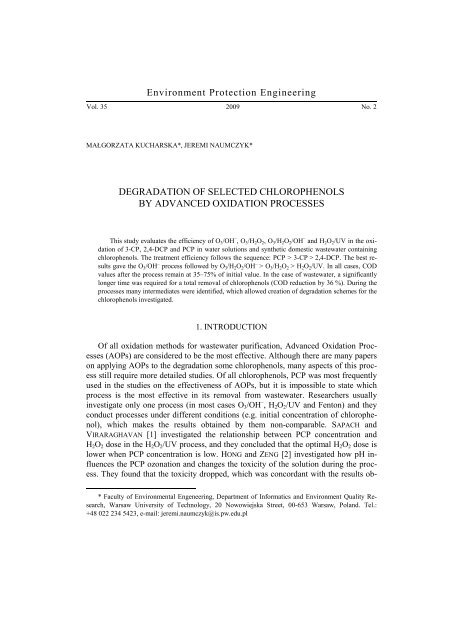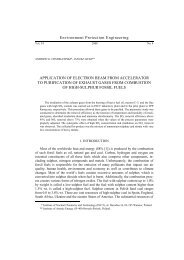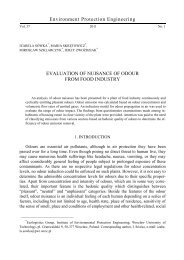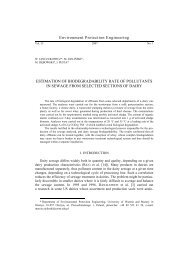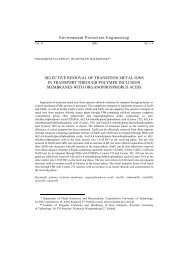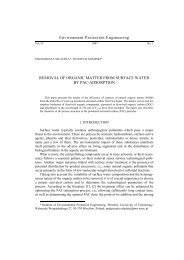Degradation of selected chlorophenols by advanced oxidation
Degradation of selected chlorophenols by advanced oxidation
Degradation of selected chlorophenols by advanced oxidation
You also want an ePaper? Increase the reach of your titles
YUMPU automatically turns print PDFs into web optimized ePapers that Google loves.
Environment Protection Engineering<br />
Vol. 35 2009 No. 2<br />
MAŁGORZATA KUCHARSKA*, JEREMI NAUMCZYK*<br />
DEGRADATION OF SELECTED CHLOROPHENOLS<br />
BY ADVANCED OXIDATION PROCESSES<br />
This study evaluates the efficiency <strong>of</strong> O 3/OH – , O 3/H 2O 2, O 3/H 2O 2/OH – and H 2O 2/UV in the <strong>oxidation</strong><br />
<strong>of</strong> 3-CP, 2,4-DCP and PCP in water solutions and synthetic domestic wastewater containing<br />
<strong>chlorophenols</strong>. The treatment efficiency follows the sequence: PCP > 3-CP > 2,4-DCP. The best results<br />
gave the O 3/OH – process followed <strong>by</strong> O 3/H 2O 2/OH – > O 3/H 2O 2 > H 2O 2/UV. In all cases, COD<br />
values after the process remain at 35–75% <strong>of</strong> initial value. In the case <strong>of</strong> wastewater, a significantly<br />
longer time was required for a total removal <strong>of</strong> <strong>chlorophenols</strong> (COD reduction <strong>by</strong> 36 %). During the<br />
processes many intermediates were identified, which allowed creation <strong>of</strong> degradation schemes for the<br />
<strong>chlorophenols</strong> investigated.<br />
1. INTRODUCTION<br />
Of all <strong>oxidation</strong> methods for wastewater purification, Advanced Oxidation Processes<br />
(AOPs) are considered to be the most effective. Although there are many papers<br />
on applying AOPs to the degradation some <strong>chlorophenols</strong>, many aspects <strong>of</strong> this process<br />
still require more detailed studies. Of all <strong>chlorophenols</strong>, PCP was most frequently<br />
used in the studies on the effectiveness <strong>of</strong> AOPs, but it is impossible to state which<br />
process is the most effective in its removal from wastewater. Researchers usually<br />
investigate only one process (in most cases O3/OH – , H2O2/UV and Fenton) and they<br />
conduct processes under different conditions (e.g. initial concentration <strong>of</strong> chlorophenol),<br />
which makes the results obtained <strong>by</strong> them non-comparable. SAPACH and<br />
VIRARAGHAVAN [1] investigated the relationship between PCP concentration and<br />
H2O2 dose in the H2O2/UV process, and they concluded that the optimal H2O2 dose is<br />
lower when PCP concentration is low. HONG and ZENG [2] investigated how pH influences<br />
the PCP ozonation and changes the toxicity <strong>of</strong> the solution during the process.<br />
They found that the toxicity dropped, which was concordant with the results ob-<br />
* Faculty <strong>of</strong> Environmental Engeneering, Department <strong>of</strong> Informatics and Environment Quality Research,<br />
Warsaw University <strong>of</strong> Technology, 20 Nowowiejska Street, 00-653 Warsaw, Poland. Tel.:<br />
+48 022 234 5423, e-mail: jeremi.naumczyk@is.pw.edu.pl
48<br />
M. KUCHARSKA, J. NAUMCZYK<br />
tained <strong>by</strong> ENGWALL et al. [3], who investigated photo-Fenton process. 2,4-DCP degradation<br />
<strong>by</strong> AOPs was comparatively less investigated. HIRVONEN and TRAPIDO [4]<br />
reported that the O3/OH – process is better than the H2O2/UV one. GRIGOROPOULOU<br />
and PHILIPPOULOS [5] compared different iron salts to be used in Fenton process –<br />
Fe2(SO4)3 and FeCl3 proved to be the best. The effectiveness <strong>of</strong> Fenton process in the<br />
case <strong>of</strong> 2,4-DCP was also investigated <strong>by</strong> BROWERS at al. [6]. The authors obtained<br />
the best results when pH was 3.5, molar ratio <strong>of</strong> H2O2 concentration to DCP was 4:1,<br />
and FeSO4 concentration was 10–100 mg Fe/dm 3 . Additionally, ORMAND et al. [7]<br />
examined the effectiveness <strong>of</strong> photo-Fenton process and they observed a significant<br />
degradation <strong>of</strong> 2,4-DCP in 60 min. Despite the fact that the results are hardly comparable,<br />
it is possible to conclude that both O3/OH – and Fenton processes are more effective<br />
than others. 3-CP has been the least investigated <strong>of</strong> all. Only DONG and<br />
HUANG [8] ascertain that Fenton process is more effective than UV/TiO2/H2O2. Other<br />
researchers studied the effectiveness <strong>of</strong> only one process, e.g. TANG and HUANG [9]<br />
examined Fenton process. Additionally, the kinetics <strong>of</strong> 3-CP ozonation was investigated<br />
<strong>by</strong> UTSUMI [10].<br />
The aim <strong>of</strong> this study was to complete the knowledge <strong>of</strong> the efficiency <strong>of</strong> AOPs in<br />
removing 3-CP, 2,4-DCP and PCP. This paper compares four AOPs which have never<br />
been examined together before. Chlorophenols examined in this study were <strong>selected</strong><br />
due to their toxicity, commonness in wastewaters, and in the case <strong>of</strong> 3-CP, limited<br />
data on them in literature.<br />
2. MATERIALS AND METHODS<br />
Chlorophenol solutions were prepared in deionized water with concentrations <strong>of</strong><br />
3-CP and 2,4-DCP <strong>of</strong> 30 mg/dm 3 and PCP <strong>of</strong> 15 mg/dm 3 (lower solubility in water).<br />
Synthetic wastewaters (COD <strong>of</strong> 318 mg/dm 3 O2) were prepared from the following<br />
ingredients (mg/dm 3 ): 3-CP (23.0), 2,4-DCP (18.0), PCP (8.8), broth (150), peptone<br />
(50), urea (30), CH3COONa (10), CaCl2 (7), NaCl (30), KCl (7) and MgSO4 (50).<br />
Initial pH values were: 12 for the O3/OH – process, 7 for O3/H2O2 and 3 for the<br />
H2O2/UV process. When chlorophenol concentration dropped to 0, the corresponding<br />
pH values (HCl was formed) were: 9, 4 and 3. The doses <strong>of</strong> H2O2 corresponded to<br />
chlorophenol/H2O2 molar ratio: 1:1, 1:2, 1:4 and (only for H2O2/UV process) 1:6.<br />
Initial H2O2 concentration was measured iodometrically. The O3/OH – and O3/H2O2<br />
processes were performed in a 1 dm 3 cylindrical reactor with a laboratory ozone generator<br />
(Sander). The ozone was supplied with the efficiency <strong>of</strong> 335 mg O3/h. The<br />
H2O2/UV process was conducted in 1 dm 3 Heraeus photoreactor, with a low pressure<br />
mercury lamp (15 W). The samples for chlorophenol, COD and (only in the case <strong>of</strong><br />
3-CP) phenolic index analyses were collected at specific time intervals during the experiments.<br />
The chlorophenol concentration and identification <strong>of</strong> <strong>oxidation</strong> intermedi-
<strong>Degradation</strong> <strong>of</strong> <strong>selected</strong> <strong>chlorophenols</strong> 49<br />
ates were analyzed according to EN 12673, using GC-MS GCQ Finnigan MAT with<br />
Rtx-5MS (0.25 μm, 30 m × 0.25 mm) capillary column and helium as carrier gas.<br />
Phenolic index was monitored using 4-aminoanthypiryne (4-AAP) method, COD –<br />
according to ISO 6060 and the consumption <strong>of</strong> ozone was determined iodometrically.<br />
All tests were performed 2–3 times.<br />
3. RESULTS AND DISCUSSION<br />
Of all AOPs investigated, O3/OH – turned out to be the most effective one. The addition<br />
<strong>of</strong> H2O2 (O3/H2O2/OH – process) did not improve the effectiveness <strong>of</strong> the process.<br />
On the contrary – when the dose <strong>of</strong> H2O2 increased, the effectiveness slightly<br />
decreased. O3/H2O2 process gave significantly worse results than O3/OH – and<br />
O3/H2O2/OH – but slightly better than H2O2/UV.<br />
The fact that the O3/OH – process had the highest efficiency in removing the <strong>chlorophenols</strong><br />
investigated could be explained <strong>by</strong> dissociation <strong>of</strong> 3-CP in alkaline solution,<br />
according to the following reaction:<br />
C6H5ClOH ↔ H + + C6H4ClO – . (1)<br />
In alkaline environment, the stable structure <strong>of</strong> the molecule is disturbed, which is<br />
why the ionic forms are more highly reactive than the non-dissociated ones.<br />
Figure 1 shows the changes in concentration <strong>of</strong> all the <strong>chlorophenols</strong> examined<br />
and the value <strong>of</strong> the phenolic index (for 3-CP) and COD (for 3-CP and 2,4-DCP)<br />
during their O3/OH – process.<br />
3.1. OXIDATION OF 3-CP<br />
The O3/OH – process resulted in 96% reduction <strong>of</strong> 3-CP concentration with 6 min<br />
and a total removal after 8 min. The O3/H2O2 process (with the addition <strong>of</strong> H2O2 in<br />
optimal dose) brought about a 97% reduction after 45 min and a total removal <strong>of</strong> 3-CP<br />
after 55 min. During the H2O2/UV process, the total removal <strong>of</strong> this compound was<br />
achieved after 60 min.<br />
During the O3/OH – process, the value <strong>of</strong> phenolic index was decreasing significantly<br />
slower than the concentration <strong>of</strong> 3-CP (figure 1). After 6 min <strong>of</strong> the reaction,<br />
the phenolic index was reduced <strong>by</strong> 87% and after 12 min it decreased to 0. The difference<br />
between the phenolic index value and the concentration <strong>of</strong> 3-CP corresponds to<br />
<strong>by</strong>-products which react with 4-AAP (therefore containing aromatic -OH groups). The<br />
concentration <strong>of</strong> <strong>by</strong>-products was increasing for about 2 min. After 3 min <strong>of</strong> conducting<br />
the process, it exceeded the concentration <strong>of</strong> 3-CP and then it decreased, but until<br />
the end <strong>of</strong> the process, it remained higher than the concentration <strong>of</strong> 3-CP. This proves<br />
that the <strong>by</strong>-products which react with 4-AAP are more resistant to <strong>oxidation</strong> than
50<br />
M. KUCHARSKA, J. NAUMCZYK<br />
3-CP. This thesis is confirmed <strong>by</strong> the characteristics <strong>of</strong> the COD changes. A very slow<br />
decrease in the COD value proves that <strong>by</strong>-products are more resistant to <strong>oxidation</strong><br />
than 3-CP. After 8 min (time <strong>of</strong> total 3-CP removal), COD decreased <strong>by</strong> 45% and<br />
after 3 h – <strong>by</strong> 51.5%. It was observed that for all parameters under analysis, the decrease<br />
in the first 6 min was very rapid, which was followed <strong>by</strong> a slow down. This<br />
phenomenon matches the consumption <strong>of</strong> O3, which was increasing considerably for<br />
the initial 6 min <strong>of</strong> the process, relatively slowing down afterwards.<br />
Fig. 1. Changes in concentration <strong>of</strong> <strong>chlorophenols</strong>, phenolic index and COD during O 3/OH – process<br />
In the O3/H2O2 process, the best results were obtained at the 3-CP:H2O2 molar ratio<br />
<strong>of</strong> 1:2. For higher H2O2 doses, the process effectiveness was lower, which could be<br />
explained <strong>by</strong> the reaction <strong>of</strong> OH • with H2O2 leading to the decay <strong>of</strong> OH • [1]. The<br />
changes in the phenolic index remained in similar relation with the concentration <strong>of</strong> 3-<br />
CP to the one <strong>of</strong> the O3/OH – process, but in this case, the difference between these<br />
parameters was lower. This difference reached its maximum in the 15th min <strong>of</strong> the<br />
reaction and after about 50 min it exceeded 3-CP concentration. The total 3-CP degradation<br />
was achieved after 55 min <strong>of</strong> the process and the phenolic index value decreased<br />
to zero after 65 min. The results presented above prove that in the O3/H2O2<br />
process, <strong>oxidation</strong> <strong>of</strong> <strong>by</strong>-products (which react with 4-AAP), derived from the degradation<br />
<strong>of</strong> 3-CP, was faster than that observed in the O3/OH – process. The reduction <strong>of</strong><br />
COD value achieved after 55 min (time <strong>of</strong> total 3-CP removal) was 43% and it did not<br />
improve further during the process.<br />
The best effectiveness <strong>of</strong> the H2O2/UV process was observed at the 3-CP:H2O2<br />
molar ratio <strong>of</strong> 1:4. As in the O3/H2O2 process, higher doses <strong>of</strong> H2O2 resulted in a reduction<br />
<strong>of</strong> the process efficiency. The explanation <strong>of</strong> this fact could be the same as in<br />
the O3/H2O2 process discussed above. The influence <strong>of</strong> H2O2 dose was more signifi-
<strong>Degradation</strong> <strong>of</strong> <strong>selected</strong> <strong>chlorophenols</strong> 51<br />
cant in the case <strong>of</strong> the phenolic index value reduction than in the concentration <strong>of</strong><br />
3-CP, which suggests that further addition <strong>of</strong> H2O2 (up to optimal dose) improved<br />
<strong>oxidation</strong> <strong>of</strong> <strong>by</strong>-products derived from the degradation <strong>of</strong> 3-CP more than 3-CP itself.<br />
In this process, the decrease in the concentration <strong>of</strong> 3-CP was slower than the decrease<br />
<strong>of</strong> the phenolic index as was observed in the processes discussed before. In this<br />
case, however, the difference between those two parameters was larger. After about<br />
20 min, the <strong>by</strong>-products concentration (which react with 4-AAP) was higher than the<br />
concentration <strong>of</strong> 3-CP remaining in the solution, and it achieved its maximum after<br />
about 30 min. This dominance was increasing during the process, at the end <strong>of</strong> which<br />
(when 3-CP was totally removed) the phenolic index value was approximately 15% <strong>of</strong><br />
the initial value – reduction to zero was achieved after 120 min <strong>of</strong> the process. Additionally,<br />
the difference discussed above was inversely dependent on H2O2 dose – its<br />
higher dose resulted in the decrease <strong>of</strong> the process efficiency.<br />
The conclusions presented above correspond with the changes in COD value observed<br />
during the process. Reduction <strong>of</strong> COD was slow, and at the end <strong>of</strong> the process<br />
(time in which all 3-CP was removed) it achieved only 25%. An increase in H2O2<br />
dose resulted in the improvement <strong>of</strong> COD reduction, but this drop was significantly<br />
smaller than those observed in the case <strong>of</strong> 3-CP concentration and the phenolic index<br />
value.<br />
3.2. OXIDATION OF 2,4-DCP<br />
During the O3/OH – process, the concentration <strong>of</strong> 2,4-DCP was reduced <strong>by</strong> 97%<br />
after 6 min and it dropped to zero after 8 min. The O3/H2O2 process (with optimal<br />
H2O2 dose) resulted in the reduction <strong>of</strong> 2,4-DCP concentration <strong>by</strong> 98% after 45 min,<br />
and a total removal was achieved after 50 min. During the H2O2/UV process,<br />
2.4-DCP was removed after 45 min in 96% and after 60 min – totally. At the end <strong>of</strong> the<br />
O3/OH – process (time <strong>of</strong> total 3-CP removal), the reduction <strong>of</strong> COD achieved 71%.<br />
The result is much better than that in the case <strong>of</strong> 3-CP and suggests that the <strong>by</strong>products<br />
<strong>of</strong> 2,4-DCP degradation are much more susceptible to <strong>oxidation</strong>. Extending<br />
the process to 3 h made the COD reduction reach only to 75%, which means<br />
that later <strong>by</strong>-products were more resistant to degradation. During the O3/H2O2 process,<br />
the correlation between 2,4-DCP and COD reduction has quite different characteristic.<br />
After 50 min <strong>of</strong> the process (time <strong>of</strong> 2,4-DCP total removal), COD was<br />
reduced only <strong>by</strong> 43%, which testifies to a different mechanism <strong>of</strong> this process and<br />
formation <strong>of</strong> a <strong>by</strong>-product less susceptible to <strong>oxidation</strong>. The influence <strong>of</strong> H2O2 dose<br />
on the effectiveness <strong>of</strong> 2,4-DCP degradation in this process was rather insignificant.<br />
The best results were obtained at the molar ratio <strong>of</strong> 2,4-DCP:H2O2 equal to 1:1.<br />
When the addition <strong>of</strong> H2O2 was higher (molar ratios <strong>of</strong> 1:2 and 1:4), the results obtained<br />
were 1–2% worse. H2O2 dose had more significant influence on the reduction<br />
<strong>of</strong> COD value, which rose slightly when the addition <strong>of</strong> H2O2 was higher. The re-
52<br />
M. KUCHARSKA, J. NAUMCZYK<br />
sults presented above prove that the dose <strong>of</strong> H2O2 has a slight influence on the<br />
mechanism <strong>of</strong> this process. During the H2O2/UV process, the best effect <strong>of</strong> 2,4-DCP<br />
degradation was observed when 2,4-DCP:H2O2 molar ratio was 1:4. Although the<br />
best reduction <strong>of</strong> COD value was achieved at H2O2 dose in a ratio <strong>of</strong> 1:6, it was<br />
slightly worse than the result obtained for H2O2 dose in a ratio <strong>of</strong> 1:4, which determined<br />
the dose <strong>of</strong> 1:4 as the optimal one. Reduction <strong>of</strong> COD after the time in which<br />
a total decomposition <strong>of</strong> 2,4-DCP was observed reached only 41%, which is the<br />
worst result <strong>of</strong> all processes under examination.<br />
3.3. OXIDATION OF PCP<br />
In the O3/OH – process, a total degradation <strong>of</strong> PCP was observed after 6 min. During<br />
the O3/H2O2 process at a molar ratio <strong>of</strong> PCP:H2O2 equal to 1:1, the concentration<br />
<strong>of</strong> PCP was reduced <strong>by</strong> 93% after 8 min and reached zero after 12 min. On the contrary<br />
to other <strong>chlorophenols</strong> examined in this study, the increase in H2O2 dose did not<br />
affect the effectiveness <strong>of</strong> the process. Additionally, ozonation without H2O2 at pH 7<br />
gave effect similar to those <strong>of</strong> O3/OH – and O3/H2O2 processes, which means that<br />
ozone itself is sufficient for <strong>oxidation</strong> <strong>of</strong> PCP in a non-dissociated form (the one<br />
which dominates at pH 7), and the addition <strong>of</strong> H2O2 (transformation <strong>of</strong> a “classic ozonation”<br />
into AOP) did not improve the effectiveness <strong>of</strong> PCP degradation. The results<br />
obtained from the H2O2/UV process are difficult to compare with the results from<br />
other processes because the PCP concentration used in this process was much lower<br />
(due to slight solubility <strong>of</strong> PCP at pH 3). However, it could be concluded that the<br />
H2O2/UV process was the least effective. With H2O2 added in the optimal dose (1:4<br />
molar ratio), the total PCP degradation occurred after 30 min.<br />
During all the processes, a decrease in pH value was observed. In the case <strong>of</strong> the<br />
processes at pH 7 and 12, the drop was about 3 units at the end <strong>of</strong> the process, and in<br />
the case <strong>of</strong> the processes at pH 3, the drop was insignificant. For all the <strong>chlorophenols</strong><br />
examined, during each process, initially colourless solutions turned firstly to pink (3-<br />
CP and 2,4-DCP) or light violet (PCP), then to orange (3-CP and 2,4-DCP) or violet<br />
(PCP), and to yellow at the end <strong>of</strong> the process.<br />
Differences in the initial concentrations <strong>of</strong> the <strong>chlorophenols</strong> examined (due to<br />
differences in their solubility dependent on pH) made it difficult to compare <strong>chlorophenols</strong><br />
directly with regard to the susceptibility to <strong>oxidation</strong> <strong>by</strong> AOPs. The investigated<br />
reactions <strong>of</strong> <strong>oxidation</strong> turned out to be first order reactions, which allowed their<br />
rate constants to be compared. According to the above-mentioned rate constants, the<br />
<strong>chlorophenols</strong> could be ordered as follows: PCP > 3-CP > 2,4-DCP. These results<br />
correspond with a tendency observed <strong>by</strong> other authors [11], [12], [13], who investigated<br />
the effectiveness <strong>of</strong> the H2O2/UV process in removing some other <strong>chlorophenols</strong><br />
as well. Some authors report that if the number <strong>of</strong> chlorine atoms in the molecule
<strong>Degradation</strong> <strong>of</strong> <strong>selected</strong> <strong>chlorophenols</strong> 53<br />
<strong>of</strong> chlorophenol rises, its susceptibility to <strong>oxidation</strong> is also higher, due to the exceeded<br />
rate <strong>of</strong> the aromatic ring dechloration [14]–[16]. Phenolic group and chlorine atom in<br />
the aromatic ring are ortho- and para-directing substituents. OH ● radicals are then<br />
supposed to attack the aromatic ring in those positions. Additionally, OH ● attacks the<br />
positions in the ring not occupied <strong>by</strong> chlorine atom, which means that fewer chlorine<br />
atoms in the ring promote the susceptibility <strong>of</strong> chlorophenol to <strong>oxidation</strong>. However,<br />
the result obtained in this study shows that the mechanisms <strong>of</strong> reactions are more<br />
complicated, and the effectiveness <strong>of</strong> the process depends also on other parameters,<br />
such as the place <strong>of</strong> chlorine atom substitution in the ring and the forms <strong>of</strong> chlorophenol<br />
(ionic or molecular) dependent on the pH value.<br />
3.4. GC-MS ANALYSIS<br />
In each process <strong>of</strong> 3-CP <strong>oxidation</strong>, some <strong>by</strong>-products were identified, among others,<br />
1-chloro-3,5-bis(1,1-dimethylo)-2-(2-propenyloxy) benzene, 2,2’-methyl bis[3,4,<br />
6-trichloro-dimethylo] phenol, cyclopropane[3,4]-cyclohepta-[1,2-a] naphtalene, and<br />
2,3,6-trichlorobenzoic acid. It is difficult to compare these results with those obtained<br />
<strong>by</strong> other authors, because there is almost no data covering this problem. Beside the<br />
above-mentioned <strong>by</strong>-products, some authors detected also: chloroorobenzenodiols,<br />
chlorodihydroxybiphenols, dichlorodihydroxybiphenols [4], catechol and pyrocatechol<br />
[16], chlorodihydroxybenzene, chlorocatechol, chlorohydroquinone [17] as <strong>by</strong>products<br />
<strong>of</strong> monochlorophenol <strong>oxidation</strong>.<br />
During <strong>oxidation</strong> 2,4-DCP the following <strong>by</strong>-products were identified: 4-chloro-1naphtalenole,<br />
4,6-dichloro-1,2-benzenodiole, 2,5-dichloro-1,4-benzenodiole and 1chloro-2,6-dimetoxynaphtalene.<br />
Some researchers observed formation <strong>of</strong> 1,4hydroquinone,<br />
chlorohydroquinone, catechol, 2-chlorohydrochinone [4], [16], polychlorinated<br />
chlorobenzenes, hydroxylated and chlorinated dibenzenes, and tri- and<br />
tetrachlorodihydroxybiphenyls [4].<br />
In the case <strong>of</strong> PCP, among main <strong>by</strong>-products <strong>of</strong> <strong>oxidation</strong> the following were indentified:<br />
2,3,5,6-tetrachloro-p-benzoquinone, 1-chloro-3,5-bis(1,1-dimethyloethylo)-<br />
2-(2-propenyloxy) benzene and lower substituted <strong>chlorophenols</strong>, e.g. 2,4-DCP. These<br />
results correspond to the results presented <strong>by</strong> other authors, who additionally identified:<br />
3,4,5-trichloro-3-cyclopentene-1,2-dion, tetrachlorophenol and carboxylic acids:<br />
3-chloro-2-hydroxy-3-metonyl-2-propenoic, 2-chloromaleic and oxalic acid [2] as <strong>by</strong>products.<br />
Based on the results obtained in this study, an <strong>oxidation</strong> scheme for 3-CP and 2,4-<br />
DCP has been created (figures 2 and 3) and confirmed the scheme <strong>of</strong> PCP <strong>oxidation</strong><br />
proposed <strong>by</strong> HONG and ZENG [2].
54<br />
OH<br />
Cl<br />
Cl<br />
HO<br />
Cl<br />
OH<br />
HO<br />
M. KUCHARSKA, J. NAUMCZYK<br />
Cl<br />
OH<br />
chlorodihydroksycykloheksadienyl<br />
chlorodihydroxycyclohexadiene<br />
OH<br />
H 2 O<br />
3-chlorocatechol<br />
OH<br />
hydroksyhydrochinone<br />
hydroxyhydroquinone + HCl<br />
maleic acid<br />
fumaric acid<br />
OH<br />
OH<br />
OH<br />
O<br />
OH<br />
Cl<br />
chlorohydrochinone 4-chlorocatechol<br />
chlorohydroquinone<br />
OH<br />
hydroxyhydroquinone<br />
hydroksyhydrochinone<br />
muconic mucic acid<br />
glycollic glioksylic acid<br />
oxalic acid tartaric acid<br />
Fig. 2. A possible scheme for <strong>oxidation</strong> <strong>of</strong> 3-CP<br />
OH<br />
Cl<br />
Cl<br />
OH<br />
OH<br />
COOH<br />
COOH<br />
muconic mucic acid<br />
OH<br />
O<br />
Cl<br />
OH<br />
Cl<br />
3,5-dichlorohydroquinone<br />
3,5-dichlorohydrochinone<br />
or or<br />
chlorohydrochinone<br />
chlorohydroquinone<br />
+ H2O<br />
OH<br />
hydroxyhydroquinone<br />
hydroksyhydrochinone<br />
O<br />
Cl<br />
+ HCl<br />
OH<br />
lub or<br />
4-chlorocatechol<br />
oxalic acid<br />
tartaric acid<br />
glycollic glioksylic acid acid<br />
Fig. 3. A possible scheme for <strong>oxidation</strong> <strong>of</strong> 2,4-DCP<br />
OH<br />
+ HCl<br />
O<br />
OH<br />
Cl<br />
+ HCl<br />
chlorohydroquinone<br />
chlorohydrochinone
<strong>Degradation</strong> <strong>of</strong> <strong>selected</strong> <strong>chlorophenols</strong> 55<br />
3.5. WASTEWATER PURIFICATION<br />
The time in which all the <strong>chlorophenols</strong> investigated were removed from the<br />
wastewater was longer than in the case <strong>of</strong> water – 14 min <strong>of</strong> the process. At this time,<br />
COD value decreased <strong>by</strong> 36%. As calculated from the previous results, a drop <strong>of</strong><br />
COD value equivalent for 3-CP <strong>oxidation</strong> was 48%, and for 2,4-DCP – 70%. These<br />
results suggest that easily biodegradable compounds were more resistant to <strong>oxidation</strong><br />
<strong>by</strong> AOPs than <strong>chlorophenols</strong>, and they did not affect significantly the effectiveness <strong>of</strong><br />
chlorophenol <strong>oxidation</strong>.<br />
BIBLIOGRAPHY<br />
[1] SAPACH R., VIRARAGHAVAN T., J. Environ. Sci., 1997, A32, 2355–2366.<br />
[2] HONG P.K.A., ZENG Y., Water Res., 2002, 36, 4243–4254.<br />
[3] ENGWALL M.A., PIGNATELLO J.J., GRASSO D., Water. Res., 1999, 33, 1151–1158.<br />
[4] HIROVEN A., TRAPIDO M., HENTUNEN J., TARHANEN J., Chemosphere, 2000, 41, 1211–1218.<br />
[5] GROGOROPOLOU H., PHILIPPOPOULOUS C., Wat. Sci. Tech., 1997, 36, 151–154.<br />
[6] BOWERS A.R., GADDIPATI P., ECKENFELDER JR., MONSEN R.M., Wat. Sci. Tech., 1989, 21, 477.<br />
[7] ORMAD M.P., OVEKKEIRO J.L., Applied Cat. B, 2001, 32,157–166.<br />
[8] DONG C., HUANG C.P., Aquatic Chemistry, 1993, ACS.<br />
[9] TANG W., HUANG C.P., Waste Managm., 1995, 15, 615–622.<br />
[10] UTSUMI H., HAN Y.-H., ICHIKAWA K., Water Res., 2003, 37, 4924–4928.<br />
[11] MOZA P.N., FYTIANOS K., SAMANIDOU V., Bull. Environ. Contam. Toxicol., 1988, 41, 678–682.<br />
[12] TRAPIDO M., VERESSININA Y., HENTUNEN J., HIRVONEN A., Environ. Technol., 1997, 18, 325–332.<br />
[13] HUGUL M., APAK R., DEMIRCI S., J. Hazard. Mat., 2000, B77, 193–208.<br />
[14] BENITEZ J.F., BELTRAN-HEREDIA J., ACERO J.L., RUBIO F.J., Chemosphere, 2000, 41,1271–1277.<br />
[15] CHEN J.N., NI C.H., Proceedings <strong>of</strong> the International Regional Conference <strong>of</strong> IOA, Poitiers, France,<br />
49.1–49.4.<br />
[16] PERA-TITUS M., GARCIA-MOLINA V., BANOS A.M., GIMENEZ J., ESPLUGAS S., Appl. Catalys. B, Environmental,<br />
2004, 47, 219–256.<br />
[17] JUNG OH-JIN, Bull. Korean. Chem. Soc., 2001, 22.<br />
ROZKŁAD WYBRANYCH CHLOROFENOLI<br />
ZA POMOCĄ WYSOKOEFEKTYWNYCH PROCESÓW UTLENIANIA<br />
Oceniano efektywność procesów O 3/OH – , O 3/H 2O 2, O 3/H 2O 2/OH – i H 2O 2/UV w usuwaniu 3-CP, 2,4-<br />
DCP i PCP z wody oraz ze ścieków <strong>by</strong>towo-gospodarczych zanieczyszczonych chlor<strong>of</strong>enolami. Badane<br />
związki pod względem podatności na degradację można uszeregować następująco: PCP > 3-CP > 2,4-<br />
DCP. Najlepsze wyniki uzyskano dla procesu O 3/OH – , gorsze dla procesów O 3/H 2O 2/OH – > O 3/H 2O 2,<br />
a najgorsze dla procesu H 2O 2/UV. We wszystkich przypadkach wartość ChZT na końcu procesu wnosiła<br />
35–75% wartości początkowej. Czas potrzebny do całkowitego usunięcia chlor<strong>of</strong>enoli ze ścieków <strong>by</strong>ł<br />
znacznie dłuższy, a ChZT obniżyło się o 36%. W czasie procesów zidentyfikowano wiele produktów<br />
pośrednich utleniania, co umożliwiło sporządzenie schematów utleniania badanych chlor<strong>of</strong>enoli.


